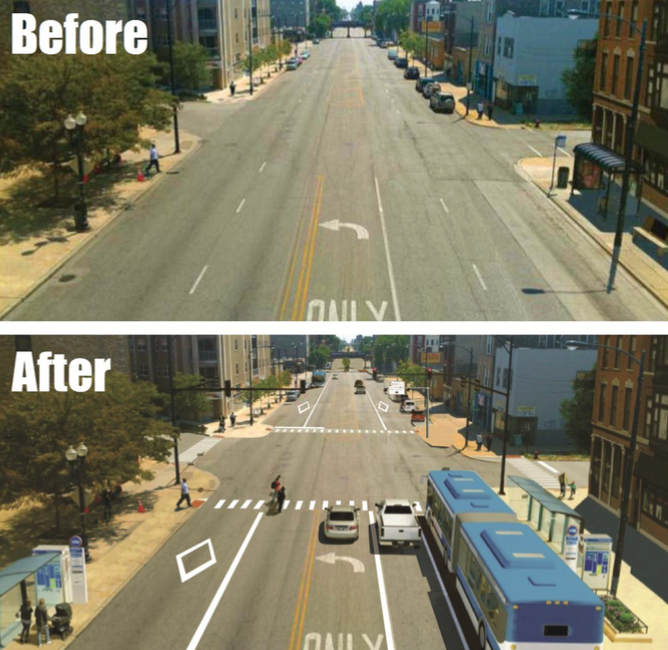Better Bus Service Coming to East Colfax But Not for at Least 5 Years

Editor’s note: To tell the city that you want a more progressive transit plan for East Colfax, get heard by submitting your comments to Denver Public Works.
The plan to build “bus rapid transit” on East Colfax is a step in the right direction that will make transit faster and more appealing on Denver’s busiest bus route. Problem is, the new bus lanes won’t be physically separated from traffic, and bus riders won’t see the improvements for at least five years.
That’s the takeaway from a public meeting Wednesday night where Denver Director of Transportation Crissy Fanganello and reps from Denver Public Works told residents how they want to move more people by prioritizing buses.
“What we’re seeing is an opportunity to move a lot more people than we could move in the number of cars, and that’s what we’re really looking for,” Fanganello said. RTD’s 15L moves about 22,000 people per weekday right now, while the upgraded version could move 50,000 according to transit planners.
The idea of upgrading bus service on Colfax has already been kicking around for a decade, and it will be at least five more years before Denverites will see the improvements. Transit planners still have to secure funding, get public feedback, and clear federal red tape. For comparison, Mexico City built about 30 miles of true BRT in five years.
Here are the major changes in store:
- Bus lanes. A bus-only lane will replace a travel lane on each side of the street for about five miles between Broadway downtown and Syracuse to the east. The bus lanes won’t be physically separated from traffic, however, since they’ll run between a general traffic lane and the parking lane. They also won’t be in effect outside of rush hours.
- 5-minute headways. Buses will arrive every five minutes, about double the frequency of current peak hour service.
- Off-board ticketing. Passengers will buy fares off the bus, saving passengers a lot of time by speeding up the boarding process.
- Better stations. Planners envision 20 new, well-lit, comfortable bus stations with real-time arrival information. Some stations will be built on extensions of the sidewalk (“bus bulbs”) so buses don’t have to pull in and out of traffic. Platform-level boarding may or may not happen.
- Traffic-signal priority. Every intersection along the route will have traffic signals that prioritize buses. This may mean that a light stays green longer if a bus is approaching, or the light could turn green preemptively, as the bus approaches.
Add them all up, and these changes should make a significant difference. Still, the bus lanes come up short compared to BRT systems in Mexico City, Bogota, or Brisbane, which have busways fully separated from other traffic.
The Colfax proposal seems more like New York’s Select Bus Service, which doesn’t make the cut as true BRT according to the Institute for Transportation and Development Policy’s scorecard. Think Broadway and Lincoln, which have a painted bus lane and signs with blinking lights that politely ask drivers to steer clear. No word yet on how the bus lane will be enforced — New York uses cameras — but one consultant said it will be worked out after the conceptual stage.
The bus will run along the street’s right side, not in the center lane, which ITDP prefers so that cars interfere less with buses.
“The center lane is an interesting question,” said Tim Baldwin, a consultant working with the city. “I am not a fan of it in an urban core because you have to limit all left turns and have to have a different kind of bus that opens on both sides. Then every person who boards the bus has to cross traffic.”
When asked whether the street could part with parking spaces, even just during rush hour, Baldwin said that’s a “policy issue.” “If you start taking away parking I guarantee you businesses on Colfax would not appreciate it,” he said. “We’re trying to find that balance with good travel time and good access.”
While the Colfax project will claim some street space for transit, it’s still a tentative step compared to what other cities are doing. Especially when you consider how little priority is devoted to transit on the whole street network. Of the five streets parallel to Colfax’s main drag, four are three-lane, one-way speedways in and out of downtown.
“[Balance] is an interesting word and other cities have obviously moved away from the word in favor of saying, ‘We’re gonna prioritize this over this,'” said Ryan Billings, the project manager with DPW. “I don’t think Denver’s quite there yet, but I think we have the opportunity to, through this dialogue, educate folks about why we’re doing these things, why taking a lane away from [cars] is actually a benefit and can move more people. It’s counterintuitive… it makes zero sense to people who only drive. But to me this is only a step one.”


